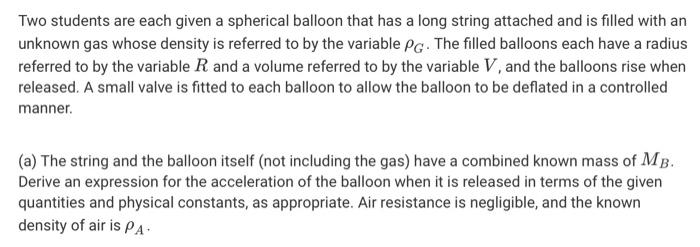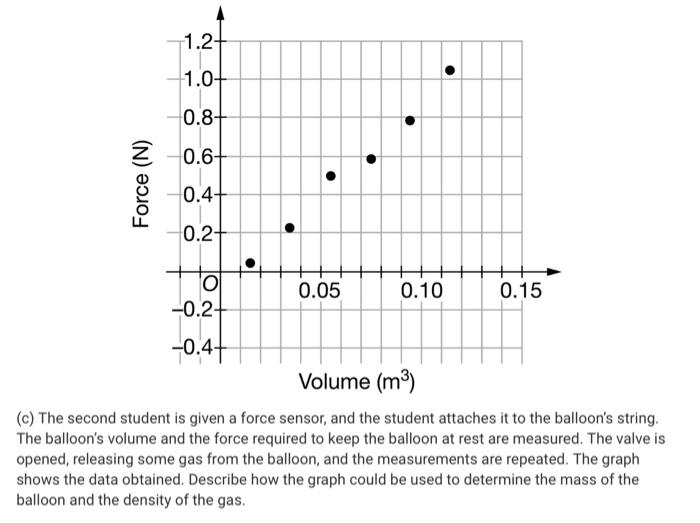Two students are each given a spherical balloon that has a long string attached and is...
Fantastic news! We've Found the answer you've been seeking!
Question:



Transcribed Image Text:
Two students are each given a spherical balloon that has a long string attached and is filled with an unknown gas whose density is referred to by the variable PG. The filled balloons each have a radius referred to by the variable R and a volume referred to by the variable V, and the balloons rise when released. A small valve is fitted to each balloon to allow the balloon to be deflated in a controlled manner. (a) The string and the balloon itself (not including the gas) have a combined known mass of MB. Derive an expression for the acceleration of the balloon when it is released in terms of the given quantities and physical constants, as appropriate. Air resistance is negligible, and the known density of air is PA- (b) The first student is given a stopwatch and a tape measure and asked to use only this equipment in an experiment to determine the density of the gas inside the balloon from a graph of the data. Describe an experimental procedure the student can use to accomplish this. 1.2+ 1.0+ 0.8+ Z -0.6- 0.4+ 0.2+ 0.05 0.10 0.15 -0.2+ -0.4+ Volume (m³) (c) The second student is given a force sensor, and the student attaches it to the balloon's string. The balloon's volume and the force required to keep the balloon at rest are measured. The valve is opened, releasing some gas from the balloon, and the measurements are repeated. The graph shows the data obtained. Describe how the graph could be used to determine the mass of the balloon and the density of the gas. Force (N) Two students are each given a spherical balloon that has a long string attached and is filled with an unknown gas whose density is referred to by the variable PG. The filled balloons each have a radius referred to by the variable R and a volume referred to by the variable V, and the balloons rise when released. A small valve is fitted to each balloon to allow the balloon to be deflated in a controlled manner. (a) The string and the balloon itself (not including the gas) have a combined known mass of MB. Derive an expression for the acceleration of the balloon when it is released in terms of the given quantities and physical constants, as appropriate. Air resistance is negligible, and the known density of air is PA- (b) The first student is given a stopwatch and a tape measure and asked to use only this equipment in an experiment to determine the density of the gas inside the balloon from a graph of the data. Describe an experimental procedure the student can use to accomplish this. 1.2+ 1.0+ 0.8+ Z -0.6- 0.4+ 0.2+ 0.05 0.10 0.15 -0.2+ -0.4+ Volume (m³) (c) The second student is given a force sensor, and the student attaches it to the balloon's string. The balloon's volume and the force required to keep the balloon at rest are measured. The valve is opened, releasing some gas from the balloon, and the measurements are repeated. The graph shows the data obtained. Describe how the graph could be used to determine the mass of the balloon and the density of the gas. Force (N)
Expert Answer:

Related Book For 

Posted Date:
Students also viewed these physics questions
-
A 1.00-L container is filled with an ideal gas and the recorded pressure is 350 atm.We then put the same amount of a real gas into the container and measure the pressure. a. If the real gas molecules...
-
A cylinder 2.4 m tall is filled with an ideal gas at standard temperature and pressure (Figure). The top of the cylinder is then closed with a tight-fitting piston whose mass is 1.4 kg and the piston...
-
A steel cylinder is filled with an ideal gas at 20C and pressure of 8.0 times atmospheric pressure. (a) The cylinder is submerged in a bath of boiling water and allowed to reach thermal equilibrium....
-
You require inventory and accounts receivable collateral for all C&I loans. You have a guideline of an advance rate of 70% for customer receivables of less than 60 days of age. Older receivables get...
-
In 2006, Evo Morales assumed the presidency in Bolivia, a South American country in which official commerce is done in Spanish. Morales is the first Bolivian president of indigenous decent. As...
-
Exercise 8.4 Inventory Turnover Average Inventory = Opening Inventory Closing Inventory 2 Opening Inventory $5,320.00 Closing Inventory $4,590.00 Total $9,910.00 Average Inventory = Average Inventory...
-
The number of weekly breakdowns of a computer is a random variable having a Poisson distribution with \(\lambda=0.2\). What is the probability that the computer will operate without a breakdown for 3...
-
The statements of financial position of Radar plc at 30 September were as follows: The following information is available: (i) An impairment review of the investments disclosed that there had been an...
-
Suppose your portfolio's daily returns follow a normal distribution with volatility = 1.5%. (i) Based on this information, what is the 10-day 95% VaR? (ii) What is the corresponding 10-day 95% ES?
-
Karen Johnson, the accountant of Hoop Co. of Nelson, has appointed Jim Pool as the petty cash custodian. The following transactions occurred in November. 2019 Nov. 25 Cheque No. 441 was written and...
-
When we turn on a light in our home or a flashlight/car headlights outside, it seems that the light travels instantaneously, but does it? Conducting a reliable internet search, find the speed at...
-
How does the concept of phenotype encompass the observable traits, characteristics, and behaviors of an organism, integrating both its genotype and environmental influences, and how do phenotypic...
-
What business and ethical reasons are there for encouraging diversity and inclusion? What works when it comes to changing employee attitudes and behaviors toward diversity and inclusion?
-
How would you describe Workforce Diversity? Why is it important for managers to have an understanding of diversity?
-
Describe at least 3 fungal pathogens of humans.
-
The profit function on a product is given by P(x) = -0.01x+4x-142, where a is the number of units sold and produced, and P(z) is the total profit, in thousands of dollars, from selling and producing...
-
Use cos(t) and sin(t), with positive coefficients, to parametrize the intersection of the surfaces 2 r(t)=(000) + y = 25 and z = 3x.
-
The value of a share of common stock depends on the cash flows it is expected to provide, and those flows consist of the dividends the investor receives each year while holding the stock and the...
-
Write the orbital diagram for the ground state of ruthenium. The configuration is [Kr]4d75s1.
-
Which of the following pictures best represents an unsaturated solution of sodium chloride, NaCl? In these pictures, the dark gray spheres represent Na+ ions and the green spheres represent chloride...
-
Shown here is a representation of a closed container in which you have just placed 10 L of H2O. In our experiment, we are going to call this starting point in time t = 0 and assume that all of the...
-
Graph the levels of real GDP for the United States, Canada, and Germany (data can be found at www.oecd.org under Statistics and then under National Accounts). Are U.S. and Canadian business cycles...
-
It has been argued that the stock market predicts recessions. Using quarterly data since 1961, plot the real value of the stock market index (the Wilshire 5000 index in the last month of the quarter...
-
In a particular economy the real money demand function is \[ \frac{M^{d}}{P}=3000+0.1 Y-10,000 i \] Assume that \(M=6000, P=2.0\), and \(\pi^{e}=0.02\). a. What is the real interest rate, \(r\), that...

Study smarter with the SolutionInn App


